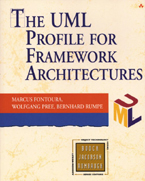Table of Content

UML Profile for Framework Architectures, The
Preface
Acknowledgments
Traces of the book's history
I: The UML -F profile
1. Why a UML profile for frameworks?
1.1 UML profiles
1.2 Object-oriented frameworks extensibility is the key
1.3 Pros and cons of frameworks
1.4 Goals of the UML -F profile
2. UML essentials for framework documentation
2.1 UML overview
2.2 Class diagrams
2.3 Object diagrams
2.4 Sequence diagrams
2.5 Summary
3. Basic elements of the UML -F profile
3.1 UML -F as a profile
3.2 UML -F tags standard UML tagged values and stereotypes unified
3.3 Standard UML tags for framework documentation
3.4 UML -F presentation tags
3.5 UML -F framework tags
3.6 The UML -F mechanism for defining new tags
3.7 Summary
4. UML -F tags for framework construction principles and patterns
4.1 Unification principle adaptation by inheritance
4.2 Separation principle adaptation through composition
4.3 Terminology and concept excursion: abstract classes, abstract coupling, Java interfaces
4.4 Hooks as name designators of pattern catalog entries
4.5 UML -F tags for framework patterns
4.6 How essential framework construction principles scale
4.7 Summary
5. Framework adaptations of UML -F pattern annotations
5.1 Cookbooks for framework adaptation
5.2 A sample cookbook recipe
5.3 Recipe for adapting the Unification construction principle
5.4 Recipe for adapting the Separation construction principle
5.5 Recipe for adapting the Composite pattern
5.6 Automating the adaptation of UML -F pattern annotations
5.7 Summary
II: UML-F @ work
6. UML -F based documentation and adaptation of the JUnit testing framework
6.1 An overview of JUnit
6.2 Recipes for defining new tests
6.3 Organizing test cases into test suites
6.4 Reporting test results
6.5 Summary
7. Hints and guidelines for the framework development and adaptation process
7.1 The cluster cycle process model of framework development and adaptation
7.2 Defining the key abstractions as an initial step
7.3 Class families, class teams, and subsystems
7.4 Identification of a framework's variation points
7.5 The AOCS framework: a case study
7.6 The AOCS manager pattern
7.7 Framelets as an aid to framework design
7.8 eXtreme Design ( XD ), with implementation cases
7.9 Framework adaptations through cookbook recipes, adaptation cases, and adaptation reports
7.10 Summary
7.11 UML -F outlook
A. UML -F tag quick reference
A.1 Tag notations
A.2 Presentation tags
A.3 Basic framework modeling tags
A.4 Essential tags for the framework construction principles
A.5 Framework pattern tags
B. UML -F tags for the GoF framework patterns
B.1 Factory Method pattern tags
B.2 Template Method pattern tags
B.3 Abstract Factory pattern tags
B.4 Bridge pattern tags
B.5 Builder pattern tags
B.6 Command pattern tags
B.7 Interpreter pattern tags
B.8 Observer pattern tags
B.9 Prototype pattern tags
B.10 State pattern tags
B.11 Strategy pattern tags
B.12 Composite pattern tags
B.13 Decorator pattern tags
B.14 Chain of Responsibility ( COR ) pattern tags
Bibliography
EAN: 2147483647
Pages: 84